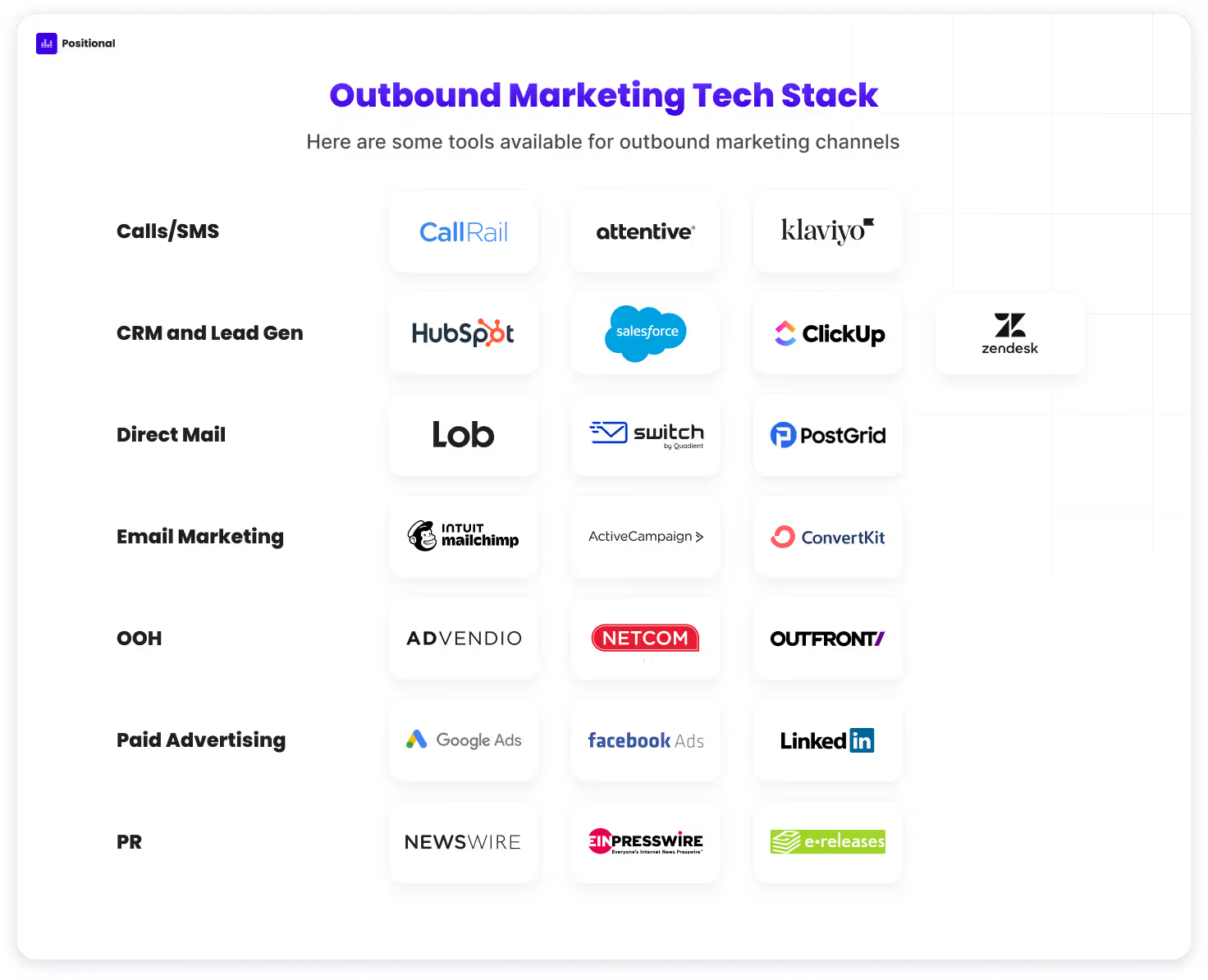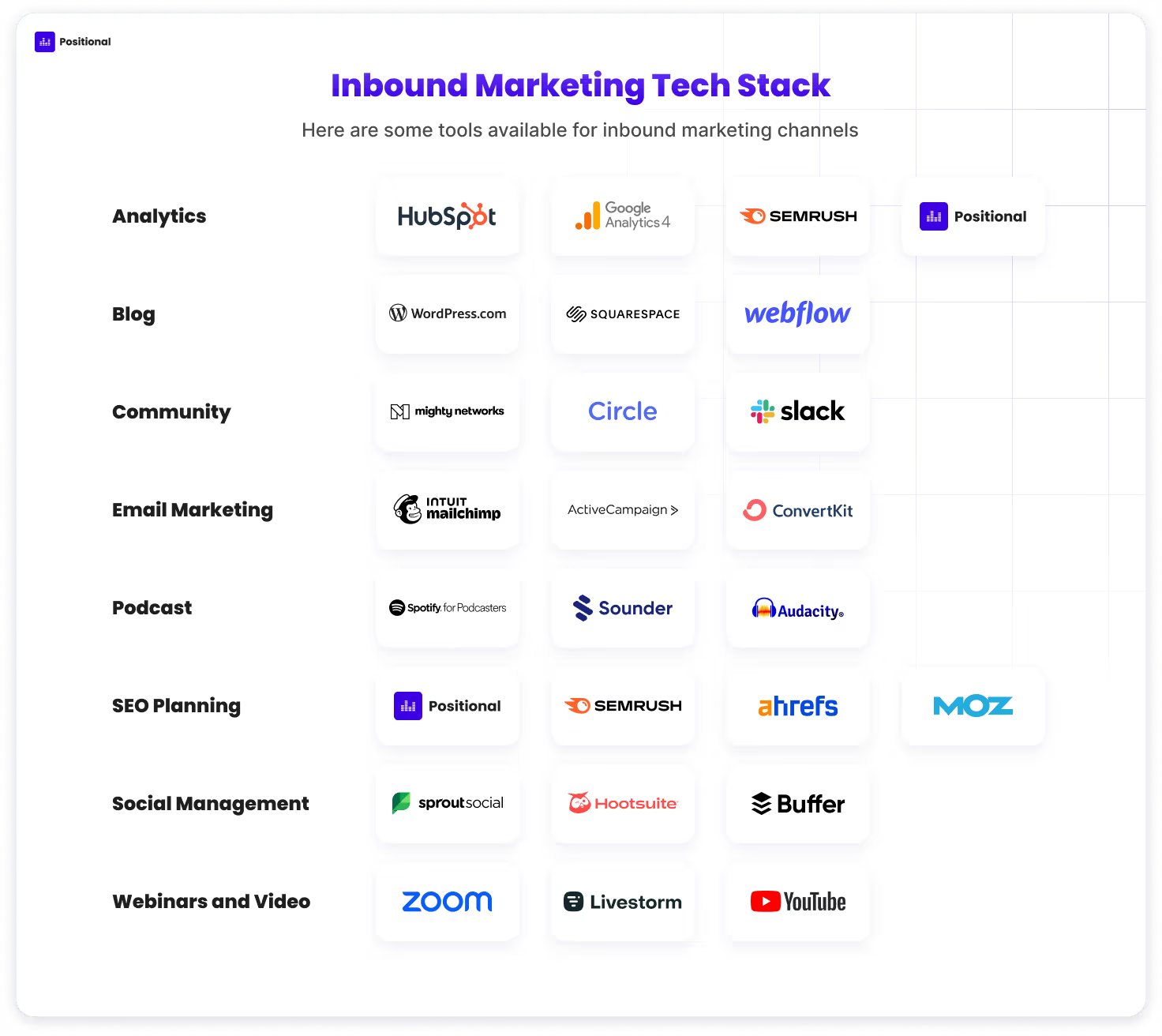Marketers casually mention “inbound” and “outbound” in conversation, but what do these terms mean in today's marketing environment? This article will provide definitions, explore the differences between inbound and outbound marketing, and explain how to use the two types of campaigns to achieve your marketing goals.
Inbound Marketing and Outbound Marketing: An Overview
Inbound marketing campaigns aim to capture specific audiences; outbound marketing campaigns push messaging to general audiences. A complete marketing strategy uses both tactics to create a sales funnel, so understanding why and how to use each is critical.
Digital marketing naturally leans toward inbound marketing, while traditional marketing focuses more on outbound. A key part of creating a comprehensive marketing strategy is matching goals with the right outbound or inbound marketing technique.
The chart below provides a high-level look at inbound marketing versus outbound marketing:

Looking at this breakdown from an internet perspective, your first thought may be that outbound strategies aren’t worthwhile (you are looking at this online, after all). But it’s important to realize that outbound has several practical applications.
What Is Outbound Marketing?
Outbound marketing strategies encompass many conventional marketing methods based on pushing messages out to a general audience. The intent is to cast a wide net and bring as many eyes to your product or service as possible. When non-marketing people think of marketing, they usually think of outbound.
An outbound message is generally interruptive, one-way, and (in most cases), non-consensual. While outbound marketing campaigns cost more and convert less, outbound is usually the easiest, most convenient way to communicate a message. Outbound tactics are largely designed to improve brand awareness, sentiment, and recall.
The timeline for outbound strategies can extend for weeks or for months. However, tracking the results can be difficult and sometimes impossible.
Types of Outbound Marketing
While outbound strategies are associated with traditional marketing channels, they’re not confined to offline spaces. Here’s a non-exhaustive list of outbound marketing examples:
- Cold calling
- Direct mail
- Display banner ads
- Event sponsorship
- Magazine ads
- Outbound email
- Out-of-home (OOH): billboards, transit, posters
- Newspaper ads
- Pop-up ads
- Press releases
- Radio ads
- Sales brochures
- Search ads
- Social media ads
- SMS promotions
- Trade shows
- TV commercials
Understanding Outbound Marketing Channels
Notice that outbound marketing strategies cover all mediums: print, radio, phone, TV, online, and in-person. Social media is an example of both outbound (ads) and inbound (organic content) marketing. SMS messages can be sales-focused (outbound) or discovery-focused (inbound).
The medium isn’t the message, but the medium will make or break the message.
Tools You Need for Outbound Marketing
Because outbound marketing tactics are so diverse, the different avenues needed for outbound marketing are, too. From traditional cold calling to email blasts and ads, there’s a modern way to approach even the most traditional methods.
Outbound Marketing Tech Stack

Here are some of the tools available for outbound marketing channels:
Calls/SMS: CallRail, Attentive, Klaviyo
CRM and Lead Gen: HubSpot, Salesforce, ClickUp, Zendesk
Direct Mail: Lob, Switch, PostGrid
Email Marketing: Mailchimp, ActiveCampaign, ConvertKit
OOH: ADvendio, NETCOM, OUTFRONT,
Paid Advertising: Google Ads, Facebook Ads, LinkedIn Ads
PR: Newswire, EIN Presswire, eReleases
What is Inbound Marketing?
Inbound marketing campaigns are considered the inverse of outbound campaigns; they are based on using value-driven content to pull in an audience. Instead of widely broadcasting a message, inbound marketing aims to drive curiosity and engagement among a specific audience.
Inbound marketing content is used to attract hand-raisers (potential customers who share their contact information), bridge them to an owned medium, and then move them through the customer journey. With a focus on relationships, inbound marketing creates transactional opportunities through trust.
While inbound marketing’s timeline can vary widely from customer to customer, most inbound efforts are easily trackable (as they are digitally focused). Inbound campaigns take time to generate momentum, making them less viable for short-term conversions but optimal for long-tail results.
Types of Inbound Marketing
Being the newer approach of the two, inbound marketing has a strong digital-first application, unlike most outbound marketing. Here’s a non-exhaustive list of inbound marketing examples:
- Blog posts
- Community building
- Customer reviews and testimonials
- E-books
- Inbound email (newsletters and nurture campaigns)
- Long-form video (YouTube, websites, and so on.)
- Online courses and certifications
- Podcasts
- Self-service tools
- SEO
- Social media
- User-generated content (UGC)
- Webinars
- Whitepapers
Understanding Inbound Marketing Channels
Not every inbound marketing campaign is created equal, though. Different types work better for different stages of the customer journey.
A social media page or podcast, like the Optimize podcast, can generate awareness. But a nurture email or a webinar is better for guiding users through the consideration stage. Inbound marketing strategies employ different tactics that work in harmony, with the goal of long-term conversion (a paid service or course, for example).
Tools You Need for Inbound Marketing
The digital marketing landscape is growing each year, so the tools available to make inbound marketing work at its best are, too. Whether you’re leading with long-form writing (SEO blogging), audio (podcasts), nurturing (email), or community, there’s a tool to fit your needs.
Inbound Marketing Tech Stack

Here are some of the tools available to meet inbound marketing needs:
Analytics: HubSpot, GA4, Semrush, Positional
Blog: WordPress, Squarespace, Webflow
Community: Mighty Networks, Circle, Slack
Email Marketing: Mailchimp, ActiveCampaign, ConvertKit
Podcast: Anchor.fm, Sounder.fm, Audacity
SEO Planning: Positional, Semrush, Ahrefs, Moz
Social Media Management: Sprout Social, Hootsuite, Buffer
Webinars and Video: Zoom, Livestorm, YouTube
Key Differences Between Inbound Marketing and Outbound Marketing
If outbound marketing is about asking customers to join the race, inbound marketing is about putting up guardrails and letting them find the finish line at their own pace.
Outbound message: “Look at our new, lower-calorie beer.”
Inbound message: “Get calories (and points) back for every sip with our rewards club.”
A mistake that many marketing teams make is using the wrong tool or messaging for the wrong tactic.
Brands may be quick to disqualify outbound marketing, but a major mistake is looking at each marketing style in isolation. Outbound marketing tactics — like Super Bowl ads, local billboards, and luxury print ads — are still highly effective, despite the better cost-effectiveness and ROI of inbound tactics.
This chart lists some of the pros and cons of inbound marketing and outbound marketing.

Is Inbound Marketing or Outbound Marketing More Effective?
As with every other strategic decision in marketing, it depends.
The Case for an Inbound Approach
In a digital-first world, inbound marketing tactics are ideal. Building a brand is one of the best ways to ensure longevity in business — with inbound marketing, the audience supporting the brand is voluntary and engaged. But brand building isn’t the only strength of inbound.
Online is where 63% of people begin consideration. Simply put, creating and spreading information online is easier, faster, and more scalable than doing so on a typical legacy medium. Inbound marketing, at its best, is meeting people when and where they need your message.
The Case for an Outbound Approach
However, outbound marketing efforts have their place. Consider every practical off-screen application for marketing — that’s outbound. Billboard ads are highly effective when applied at the right time, at the right location, and in the right social context. The Super Bowl still has the hype of having the biggest, boldest, and most effective ads every year.
While we live in a digital culture, we don’t spend every second looking at screens. Older demographics and legacy mediums still rely on outbound marketing, and for large brands, both tactics can be a part of a greater marketing strategy.
If your goal is an organic, relationship-focused, lower-cost campaign, inbound marketing channels are more optimal.
If your goal is building awareness at scale while growing in the short term, outbound marketing channels are more optimal.
Final Thoughts
Understanding the differences between inbound marketing and outbound marketing may seem elementary on the surface. However, too few marketers take time to consider their differences and ideal applications. As a result, marketing teams are stuck deploying tactics that are misaligned with their goals.
The ability to segment inbound and outbound marketing demonstrates discipline and focus in a marketing strategy. More importantly, clearly considering the benefits of inbound marketing techniques versus the benefits of outbound marketing techniques reduces the likelihood of executing a mismatched strategy.
At Positional, we help marketing and SEO professionals improve long-term inbound marketing strategies. Features like our Content Planner dial in your content pillars and topics, while Optimize and Keyword Clustering help you dig in and refine keyword strategy.
Optimizing content, and your inbound marketing strategy, starts here.





